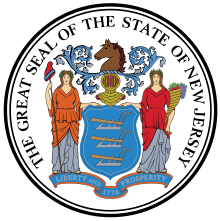New Jersey Legislative Council
The New Jersey Legislative Council was the upper house of the New Jersey Legislature under the New Jersey Constitution of 1776 until it was replaced by the New Jersey Senate under the Constitution of 1844.
New Jersey Legislative Council | |
|---|---|
 | |
| Type | |
| Type | Upper House of the New Jersey Legislature |
| Leadership | |
President of Council | The Governor |
Various | |
| Structure | |
| Seats | 13-18 |
Political groups | |
| Meeting place | |
| New Jersey State House, Trenton, New Jersey | |
History
The Legislative Council replaced the New Jersey Provincial Council, which had been the upper house under colonial rule. The Provincial Council consisted of up to twelve members, appointed by and serving at the pleasure of the British crown. As this created an overly aristocratic and non representative body, the framers of the 1776 state constitution provided for an elected Legislative Council, with one Member of Council elected in each county for a one-year term.[1] This structure would remain in place after 1844, when the Legislative Council would be replaced by the New Jersey Senate, and continued until 1965.
Composition
The 1776 Constitution set up a fusion of powers system of state government, which allowed for an overlap of executive, legislative and judicial authority. It provided for a bicameral legislature consisting of a General Assembly with three members from each county and a Legislative Council with one member from each county.[2] All state officials, including the governor, were to be appointed by the Legislature under this constitution. The Vice-President of Council would succeed the Governor (who was the President of the Council) if a vacancy occurred in that office.[2] The Governor was elected to a one-year term by the Legislative Council and the General Assembly — in joint meeting — and served, with casting vote, as the President of the Council. The Legislative Council itself chose one of its members to be Vice-President of Council who would succeed if a vacancy occurred in the Governor's office.[3] Each county elected one member for a one-year term. Members were required to be "an inhabitant and freeholder in the county in which he is chosen, and worth at least one thousand pounds proclamation money, of real and personal estate, within the same county".[4] Thirteen counties in 1776 increased to eighteen by 1844.

Powers
In addition to electing the Governor, the Legislative Council and the General Assembly — in joint meeting — chose the Judges of the New Jersey Supreme Court, Judges of the Inferior Court of Common Pleas, Justices of the Peace, Clerks of the Supreme Court, County Clerks, Attorney General, and Secretary of State.[5]
Under the fusion of powers system, the Governor and Council comprised the Court of Appeals, "in the last resort", continuing the system in use under colonial rule.[6] Three or more Members of the Legislative Council were to be a privy council to the Governor.[7]
Under the 1776 constitution, the Legislative Council had the same powers as the Assembly in the introduction and passage of bills, with the exception that the Council could not "prepare or alter any money bill"; that authority was left to the Assembly alone. Sessions of the Legislative Council could only be convened while the Assembly was sitting. The Speaker of the Assembly was required to notify the Governor or Vice President of Council at each adjournment of the lower house of the time at which it would reconvene.[8]
List of past Vice-Presidents of Council
The following is a list of past Vice-Presidents of the New Jersey Legislative Council from the adoption of the 1776 State Constitution.[9]
- 1776-81: John Stevens, Hunterdon
- 1782: John Cox, Burlington
- 1783-84: Philemon Dickinson, Hunterdon
- 1785-88: Robert Lettis Hooper, Jr., Hunterdon
- 1789-92: Elisha Lawrence, Monmouth (acting Governor 1790)
- 1793-94: Thomas Henderson, Monmouth (acting Governor 1793 & 1794)
- 1795: Elisha Lawrence, Monmouth
- 1796-97: James Linn, Somerset
- 1798-1800: George Anderson, Burlington
- 1801-04: John Lambert, Hunterdon (acting Governor 1802-03)
- 1805: Thomas Little, Monmouth
- 1806: George Anderson, Burlington
- 1807: Ebenezer Elmer, Cumberland
- 1808: Ebenezer Seeley, Cumberland
- 1809: Thomas Ward, Essex
- 1810-11: Charles Clark, Essex (acting Governor 1812)
- 1812: James Schureman, Middlesex
- 1813: Charles Clark, Essex
- 1814-15: William Kennedy, Sussex (acting Governor 1815)
- 1816-22: Jesse Upson, Morris
- 1823-25: Peter J. Stryker, Somerset
- 1826: Ephraim Bateman, Cumberland
- 1827: Silas Cook, Morris
- 1828: Caleb Newbold, Burlington
- 1829-30: Edward Condict, Morris
- 1831-32: Elias P. Seeley, Cumberland (acting Governor 1833)
- 1833: Mahlon Dickerson, Morris
- 1834: Jehu Patterson, Monmouth
- 1835: Charles Sitgreaves, Warren
- 1836: Jeptha B. Munn, Morris
- 1837-38: Andrew Parsons, Passaic
- 1839-40: Joseph Porter, Gloucester
- 1841: John Cassedy, Bergen
- 1842: William Chetwood, Essex
- 1843: James Patterson, Monmouth
- (1844 elections were for the new New Jersey Senate that met in January 1845)
References
- Richard J. Connors, The Constitution of 1776
- See: New Jersey Legislature#Before the Legislature and the Constitution of 1776.
- 1776 New Jersey Constitution, Article VII
- 1776 New Jersey Constitution, Article III
- 1776 New Jersey Constitution, Article XII
- 1776 New Jersey Constitution, Article IX
- 1776 New Jersey Constitution, Article VIII
- 1776 New Jersey Constitution, Article VI
- List from "Manual of the Legislature of New Jersey", date: various (pre 1950)